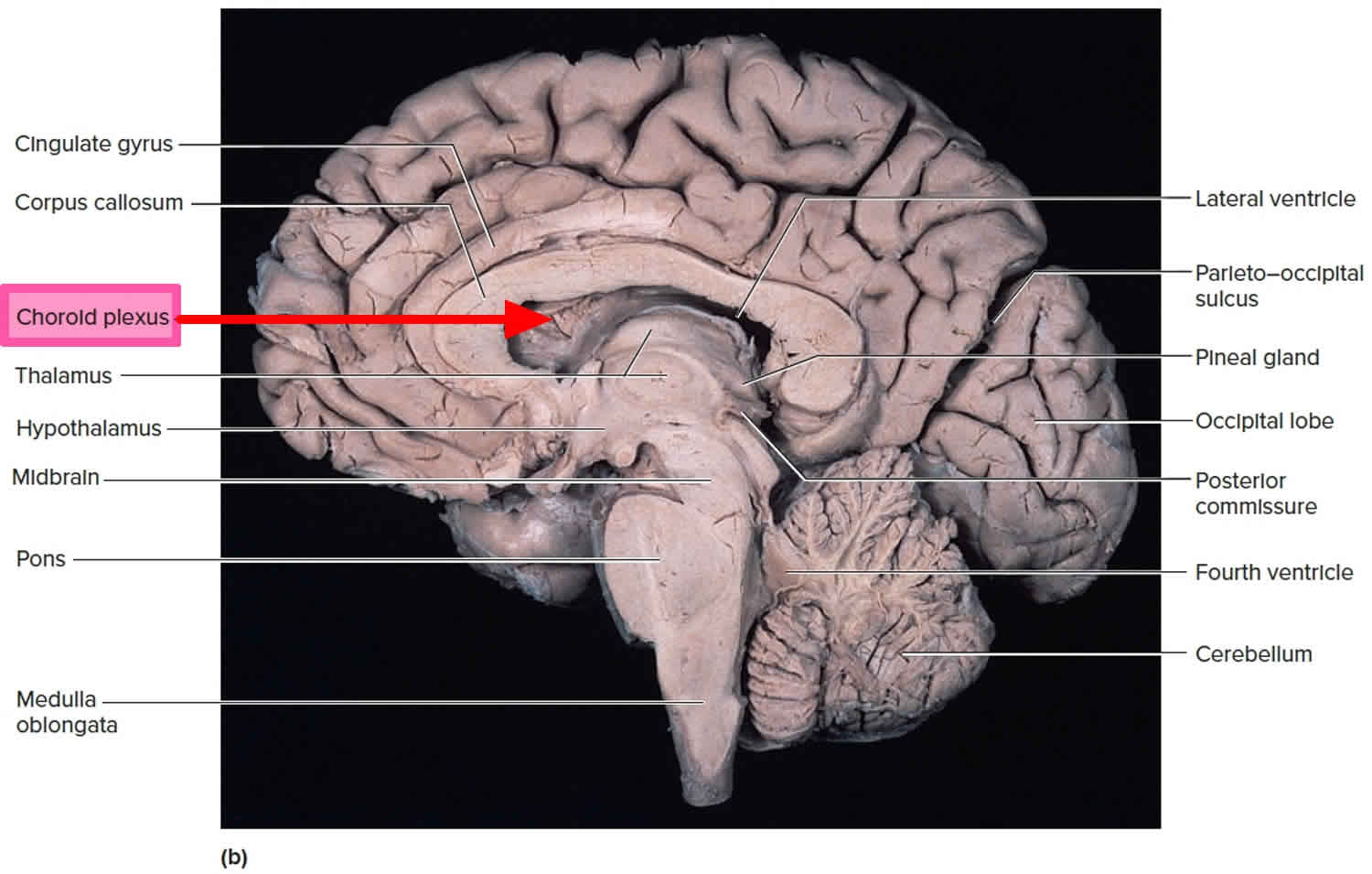Immersed within the brain’s fluid-filled ventricles, the choroid plexus stands as a remarkable physiological tapestry, meticulously crafted from an intricate network of capillaries and a specialized epithelial cell layer. Together, these components orchestrate a vital symphony, producing cerebrospinal fluid (CSF) — the lifeblood that nourishes, protects, and cushions the delicate neural tissues of the central nervous system.

Image: healthjade.com
The choroid plexus traces its lineage back to the embryonic period, when it emerges as a highly vascularized structure from the roof of the developing brain’s ventricles. As the fetus transitions into the postnatal world, the choroid plexus persists, assuming its pivotal role in CSF production. This intricate vascular meshwork, adorned with epithelial cells, actively secretes CSF into the ventricular system, replenishing the fluid every few hours to maintain its delicate balance of ions, nutrients, and neuroprotective factors.
Epithelial Cells: Sentinels of the Neural Environment
The epithelial cells lining the choroid plexus capillaries serve as meticulous guardians of the brain’s microenvironment. Their highly specialized apical surfaces, teeming with microvilli, form elaborate brush borders that dramatically increase the surface area available for fluid secretion. These cells diligently transport essential ions, such as sodium, potassium, and chloride, from the capillaries into the nascent CSF. Additionally, they synthesize and secrete a plethora of important molecules, including proteins, glycoproteins, and growth factors, endowing CSF with its unique biochemical composition.
The epithelial cells are not mere passive bystanders but actively modulate CSF composition in response to the ever-changing demands of the brain. They possess receptors for various neurotransmitters and hormones, allowing them to fine-tune CSF production and composition in harmony with the brain’s metabolic and signaling needs.
Capillaries: The Lifeline of the Choroid Plexus
The capillaries of the choroid plexus, nestled within the epithelial cell layer, form the vascular scaffold upon which the magic of CSF production unfolds. Their fenestrated nature — adorned with numerous microscopic pores — allows for the rapid exchange of fluids and solutes between the blood and the nascent CSF. This intricate vascular network ensures a continuous supply of nutrients and oxygen to the epithelial cells, fueling their tireless efforts in maintaining the brain’s vital fluidic environment.
Transport Mechanisms: A Symphony of Molecular Movements
The coordinated efforts of ion channels, transporters, and aquaporins orchestrate the intricate symphony of fluid and solute movement across the choroid plexus epithelium. Sodium-potassium ATPases, the workhorses of ion transport, diligently establish the ion gradients that drive CSF secretion. Transporters, with their specific molecular recognition capabilities, facilitate the selective movement of other ions, nutrients, and molecules into or out of the CSF. Aquaporins, specialized water channels, enable the rapid flux of water, ensuring the proper hydration of CSF and brain tissues.

Image: clinicalgate.com
CSF: Nourishment and Protection for the Neural Realm
Cerebrospinal fluid, a crystal-clear liquid, bathes the brain and spinal cord, providing vital nourishment and protection to the delicate neural tissues. It transports essential nutrients, such as glucose and amino acids, to fuel the metabolic needs of neurons and glial cells. It also whisks away waste products, including carbon dioxide, to maintain a healthy cellular environment.
The protective role of CSF extends beyond its nutritive functions. It acts as a shock absorber, cushioning the brain from mechanical trauma and mitigating the harmful effects of impact forces. Additionally, CSF contains immune cells and antimicrobial molecules, safeguarding the central nervous system from infections and inflammatory insults.
Dysfunction of the Choroid Plexus: A Ripple Effect in the Brain
Dysfunction of the choroid plexus can disrupt the delicate balance of the brain’s fluid environment, leading to a cascade of neurological consequences. Reduced CSF production can result in hydrocephalus, a condition characterized by abnormally enlarged ventricles and increased intracranial pressure. Conversely, excessive CSF production can cause normotensive hydrocephalus, where normal-sized ventricles exert pressure on surrounding brain structures.
Impairments in CSF composition can also have far-reaching effects. Altered ion concentrations can disrupt neuronal signaling and excitability, contributing to neurological disorders such as epilepsy and neurodegenerative conditions like Alzheimer’s disease. Moreover, defects in the secretion of protective factors can compromise the brain’s ability to resist oxidative stress and inflammation.
Therapeutics: Targeting the Choroid Plexus
Harnessing the knowledge of choroid plexus physiology has opened novel therapeutic avenues for treating a range of neurological disorders. Scientists are exploring pharmacological approaches to modulate CSF production and composition, aiming to alleviate symptoms and improve outcomes in conditions such as hydrocephalus and neurodegenerative diseases. The choroid plexus also holds promise as a potential target for drug delivery, providing a direct route for therapeutics to reach the central nervous system.
The Choroid Plexus Is Made From Capillaries And ______.
Conclusion: A Pivotal Nexus in the Brain’s Ecosystem
The choroid plexus, meticulously crafted from capillaries and specialized epithelial cells, stands as a pivotal nexus in the brain’s intricate ecosystem. Its relentless production and modulation of cerebrospinal fluid nourishes and protects the delicate neural circuitry, ensuring optimal brain function. Dysregulation of this intricate tapestry can have profound neurological consequences, highlighting the critical importance of understanding and safeguarding the choroid plexus for enduring brain health. Continued research into this remarkable structure promises to uncover novel therapeutic strategies, paving the way for improved treatments for a range of